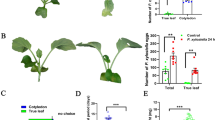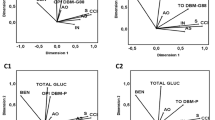Abstract
The diamondback moth Plutella xylostella (Linnaeus, 1758) (Lepidoptera: Plutellidae) is an herbivorous specialist on Brassicaceae species. Brassicas spp. plants developed a range of defenses (chemical, physical, and morphological) to prevent herbivores attack. In this study, we reported the antixenotic and antibiotic effects of outermost layer of two species of epicuticular wax of Brassicaceae, Brassica oleracea L. var. “Santo Antônio,” and Hybrid Kope F1 100MX, on larvae and adult of P. xylostella. In the choice experiment, P. xylostella adults showed an oviposition preference for collard cultivars Santo Antônio (control) and Hybrid Kope F1 100MX with wax removal. In the no-choice experiment, oviposition was 6.4 times higher in the Hybrid Kope F1 100MX with wax removal than without wax removal. There were significant differences among larvae feeding on leaf disks of Hybrid Kope F1 100MX in the treatments with (65.3 mg) and without wax removal (23.5 mg). The net reproduction rate (R 0 ), and intrinsic (rm) and finite rates of increase (λ) of P. xylostella in the cv. Santo Antônio were bigger in the treatment without wax removal (R 0 = 50.4, rm = 0.23 and λ = 1.26) than treatment with wax removal (R 0 = 28.5, rm = 0.20 and λ = 1.22). However, only the R 0 value was affected by mechanical wax removal in the Hybrid Kope F1 100MX (with wax removal R 0 = 43.3 and without wax removal R 0 = 30.8). In conclusion, the results indicate that collard’s wax is important to accessibility and development of P. xylostella, and its removal changes the resistance of collard’s varieties to P. xylostella.




Similar content being viewed by others
References
Agerbirk N, Olsen CE, Bibby BM, Frandsen HO, Brown LD, Nielsen JK, Renwick JAA (2003) A saponin correlated with variable resistance of Barbarea vulgaris to the diamondback moth Plutella xylostella. J Chem Ecol 29:1417–1433
Asghari A, Fathi SAA, Mohammadi SA, Mohammaddust H (2009) QTL analysis for diamondback moth resistance in canola (Brassica napus L.) Int J Plant Production 3:29–34
Awmack CS, Leather SR (2002) Host plant quality and fecundity in herbivorous insects. Annu Rev Entomol 47. doi:10.1146/annurev.ento.47.091201.145300
Bacci L, Picanço MC, Barros EC, Rosado JF, Silva GA, Silva VF, Silva NR (2009) Physiological selectivity of insecticides to wasps (hymenoptera: Vespidae) preying on the diamondback moth. Sociobiology 53:151–167
Badenes-Perez FR, Gershenzon J, Heckel DG (2014) Insect attraction versus plant defense: young leaves high in glucosinolates stimulate oviposition by a specialist herbivore despite poor larval survival due to high saponin content. PLoS One 9(4):e95766. doi:10.1371/journal.pone.0095766
Baek JH, Kim JI, Lee DW, Chung BK, Miyata T, Lee SH (2005) Identification and characterization of ace1-type acetylcholinesterase likely associated with organophosphate resistance in Plutella xylostella. Pestic Biochem Phys 81:164–175
Bukovinszky T, Potting RPJ, Clough Y, Van Lenteren JC, Louise EMV (2005) The role of pre- and post-alighting detection mechanisms in the responses to patch size by specialist herbivores. Oikos 109:435–446
Chagas Filho NR, Boiça Junior AL, Alonso TF (2010) Biologia de Plutella xylostella L. (Lepidoptera: Plutellidae) em cultivares de couve-flor. Neotrop Entomol 39:253–259
Chapman RF (1977) The role of the leaf surface in food selection by acridids and other insects. Colloq Int CNRS 265:133–149
Charleston DS, Kfir R (2000) The possibility of using Indian mustard, Brassica juncea as a trap crop for the diamondback moth, Plutella xylostella, in South Africa. Crop Prot 19:455–460
Eigenbrode SD, Nelson NK, Stoner KA (1999) Predation, behavior, and attachment by Chrysoperla plorabunda larvae on Brassica oleracea with different surface waxblooms. Entomol Exp Appl 90:225–235
Fathi SAA, Bozorg-Amirkalaee M, Sarfaraz RM (2011) Preference and performance of Plutella xylostella (L.) (Lepidoptera: Plutellidae) on canola cultivars. J Pestic Sci 84:41–47
Ferré J, Real MD, Van Rie J, Jansens S, Peferoen M (1991) Resistance to the Bacillus thuringiensis bioinsecticide in a field population of Plutella xylostella is due to a change in a midgut membrane receptor. P Natl Acad Sci 88:5119–5123
Filgueira FAR (2008) Novo manual de olericultura: Agrotecnologia moderna na produção e comercialização de hortaliças. Editora UFV, Viçosa, p 421
Gigolashvili T, Yatusevich R, Berger B, Müller C, Flügge UI (2007) The R2R3-MYB transcription factor HAG1/MYB28 is a regulator of methionine-derived glucosinolate biosynthesis in Arabidopsis thaliana. Plant J 51:247–261
Golizadeh A, Kamali K, Fathipour Y, Abbasipour H (2009) Life table of the diamondback moth, Plutella xylostella (L.) (Lepidoptera: Plutellidae) on five cultivated brassicaceous host plants. J Agr Sci Technol 11:115–124
Gotelli JN (2009) Ecologia. Editora Planta, Londrina, Brasil, p 302
Grubb CD, Steffen A (2006) Glucosinolate metabolism and its control. Trends Plant Sci 11:89–100
Halkier BA, Gershenzon J (2006) Biology and biochemistry of glucosinolates. Annu Rev Plant Biol 57:303–333
Hasan F, Ansari MS (2011) Effects of different brassicaceous host plants on the fitness of Pieris brassicae (L.) Crop Prot 30:854–862
Hopkins RJ, van Dam NM, van Loon JJ (2009) Role of glucosinolates in insect-plant relationships and multitrophic interactions. Annu Rev Entomol 54:57–83
Husebye H, Chadchawan S, Winge P, Thangstad OP, Bones AM (2002) Guard cell- and phloem idioblast-specific expression of thioglucoside glucohydrolase 1 (myrosinase) in Arabidopsis. Plant Physiol 128:1180–1188
Ishida M, Hara M, Fukino N, Kakizaki T, Morimitsu Y (2014) Glucosinolate metabolism, functionality and breeding for the improvement of Brassicaceae vegetables. Breeding Sci 64:48–59
Kliebenstein DJ, Kroymann J, Mitchell-Olds T (2005) The glucosinolate–myrosinase system in an ecological and evolutionary context. Curr Opin Plant Biol 8:264–271
Koroleva OA, Davies A, Deeken R, Thorpe MR, Tomos D, Hedrich R (2000) Identification of a new glucosinolate-rich cell type in Arabidopsis flower stalk. Plant Physiol 124:599–608
Lewontin AC (1965) Selection for coloning ability. In: Baker HG, Stebbins GL (eds) The genetics of colonizing species. Academic Press, New York, pp 79–94
Müller C, Hilker M (2001) Host finding and oviposition behavior in a chrysomelid specialist – the importance of host plant surface waxes. J Chem Ecol 27:985–994
Müller R, Vos M, Sun JY, Sonderby IE, Halkier BA, Wittstock U, Jande G (2010) Differential effects of indole and aliphatic glucosinolates on lepidopteran herbivores. J Chem Ecol 36:905–913
Renwick JAA, Haribal M, Gouinguené S, Städler E (2006) Isothiocyanates stimulating oviposition by the diamondback moth, Plutella xylostella. J Chem Ecol 32:755–766
Rondelli VM, Pratissoli D, Polanczyk RA, Marques EJ, Sturm GM, Tiburcio MO (2011) Associação do óleo de mamona com Beauveria bassiana no controle da traça-das-crucíferas. Pesqui Agropecu Bras 6:212–214
Sarosh BR, Wittstock U, Halkier BA, Ekbom B (2010) The influence of metabolically engineered glucosinolates profiles in Arabidopsis thaliana on Plutella xylostella preference and performance. Chemoecology 20:1–9
Schoonhoven LM, Van Loon JJA, Dicke M (2005) Insect-plant biology. Oxford University Press, New York, p 440
Schuler TH, Martinez-Torres D, Thompson AJ, Denholm I, Devonshire AL, Duce IR, Williamson MS (1998) Toxicological, electrophysiological, and molecular characterization of knockdown resistance to pyrethroid insecticides in the diamondback moth, Plutella xylostella (L.) Pestic Biochem Phys 59:169–182
Silva GA, Picanço MC, Bacci L, Crespo ALB, Rosado JF, Guedes RNC (2011) Control failure likelihood and spatial dependence of insecticide resistance in the tomato pinworm, Tuta absoluta. Pest Manag Sci 67:913–920
Smith CM (2005) Plant resistance to arthropods: molecular and conventional approaches. Springer Science & Business Media, Netherlands, p 423
Southwood TRE (1978) Ecological methods with particular reference to the study of insect populations. Chapman & Hall, London, p 524
Spencer JL, Pillai S, Bernays EA (1999) Synergism in the oviposition behavior of Plutella xylostella: sinigrin and wax compounds. J Insect Behav 2:483–500
Städler E (2002) Plant chemical cues important for egg deposition by herbivorous insects. In: Hilker M, Meiners T (eds) Chemoecology of insect ggs and egg deposition. Blackwell Publishing Ltda, Berlin, pp 171–204 240p
Sun JY, Sonderby IE, Halkier BA, Jander G, Vos M (2009) Non-volatile intact indole glucosinolates are host recognition cues for ovipositing Plutella xylostella. J Chem Ecol 35:1427–1436
Syed TS, Abro GH (2003) Effect of Brassica vegetable hosts on biology and life table parameters of Plutella xylostella under laboratory conditions. Pak J Biol Sci 6:1891–1896
Thuler RT, Bortoli SA, Hoffmann-Campo CB (2007) Classificação de cultivares de brássicas com relação à resistência à traça-das-crucíferas e à presença de glucosinolatos. Pesqui Agropecu Bras 42:467–474
Ulmer B, Gillott C, Woods D, Erlandson M (2002) Diamondback moth, Plutella xylostella (L.), feeding and oviposition preferences on glossy and waxy Brassica rapa (L.) lines. Crop Prot 21:327–331
Wang X, Wu S, Gao W, Wu Y (2015) Dominant inheritance of field-evolved resistance to fipronil in Plutella xylostella (Lepidoptera: Plutellidae). J Econ Entomol 109:334–338
Acknowledgements
To the National Council of Scientific and Technological Development (CNPq) and the Minas Gerais State Foundation for Research Aid (FAPEMIG) for granting scholarships and resources to conduct the research, and the Post-Graduate Program in Entomology and Plant Science at the Federal University of Viçosa for providing support facilities.
Author information
Authors and Affiliations
Corresponding author
Additional information
Edited by Fabio S Nascimento
Rights and permissions
About this article
Cite this article
Silva, G.A., Pereira, R.M., Rodrigues-Silva, N. et al. Wax Removal and Diamondback Moth Performance in Collards Cultivars. Neotrop Entomol 46, 571–577 (2017). https://doi.org/10.1007/s13744-017-0493-3
Received:
Accepted:
Published:
Issue Date:
DOI: https://doi.org/10.1007/s13744-017-0493-3




